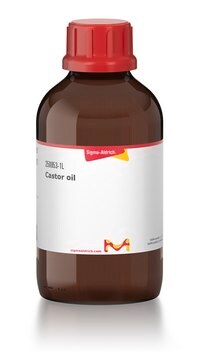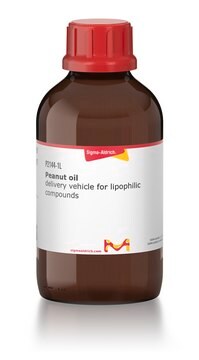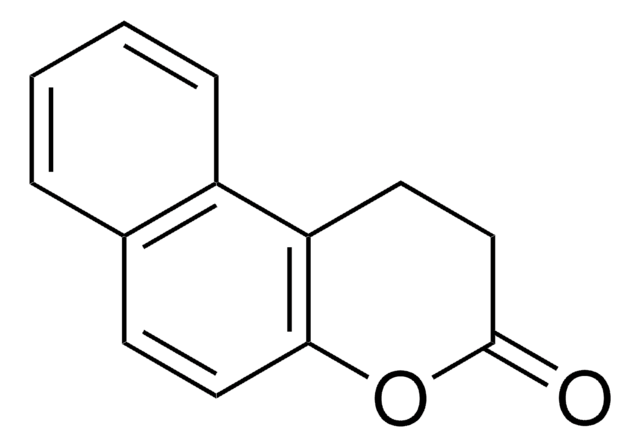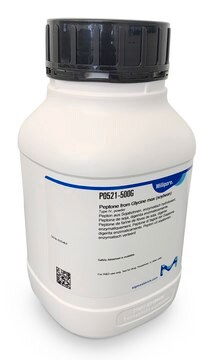S5007
Sunflower seed oil
from Helianthus annuus, liquid, emollient
Sign Into View Organizational & Contract Pricing
All Photos(1)
About This Item
Recommended Products
product name
Sunflower seed oil from Helianthus annuus,
density
0.92 g/mL at 25 °C (lit.)
Quality Level
Looking for similar products? Visit Product Comparison Guide
General description
Sunflower seed oil from Helianthus annuus contains saturated fatty acids (palmitic and stearic acids), monounsaturated fatty acid (oleic acid), and polyunsaturated acid (mostly linoleic acid). In addition, this edible oil also contains nonglyceridic contents including tocopherols and plant sterols, and is rich in vitamins and minerals.
Application
Sunflower seed oil from Helianthus annuus was used as a vehicle to administer tamoxifen and 4-hydroxytamoxifen to mice.
Biochem/physiol Actions
Sunflower seed oil is one of the most used vegetable oils in human nutrition. Oilseed crop sunflower (Helianthus annuus) is also used for biodiesel production. Sunflower oil is used as an emollient in cosmetics, and it serves as an effective phenolic antioxidant. Phytosterols in sunflower oil help in regulating the cholesterol levels in the body. Therefore, sunflower oil may be used to treat pathological conditions such as like acne, arthritis, and hair damage.
Supplementary Hazards
Storage Class Code
10 - Combustible liquids
WGK
WGK 3
Flash Point(F)
>230.0 °F
Flash Point(C)
> 110 °C
Personal Protective Equipment
dust mask type N95 (US), Eyeshields, Gloves
Certificates of Analysis (COA)
Search for Certificates of Analysis (COA) by entering the products Lot/Batch Number. Lot and Batch Numbers can be found on a product’s label following the words ‘Lot’ or ‘Batch’.
Already Own This Product?
Find documentation for the products that you have recently purchased in the Document Library.
Customers Also Viewed
Adam B Sendor et al.
Gastrointestinal cancer : targets and therapy, 5, 61-71 (2015-04-07)
PTEN loss contributes to the development of liver diseases including hepatic steatosis and both hepatocellular carcinoma (HCC) and cholangiocarcinoma (CC). The factors that influence the penetrance of these conditions are unclear. We explored the influence of sustained hypoxia signaling through
Vegetable oils: Dietary importance
"Reference Module in Food Science (2016)
Rayan Naser et al.
Scientific reports, 6, 20230-20230 (2016-02-06)
Adult neural stem cells (aNSCs) are relatively quiescent populations that give rise to distinct neuronal subtypes throughout life, yet, at a very low rate and restricted differentiation potential. Thus, identifying the molecular mechanisms that control their cellular expansion is critical
Myelin remodeling through experience-dependent oligodendrogenesis in the adult somatosensory cortex.
Ethan G Hughes et al.
Nature neuroscience, 21(5), 696-706 (2018-03-21)
Oligodendrocyte generation in the adult CNS provides a means to adapt the properties of circuits to changes in life experience. However, little is known about the dynamics of oligodendrocytes and the extent of myelin remodeling in the mature brain. Using
Andria R Robinson et al.
Redox biology, 17, 259-273 (2018-05-11)
Accumulation of senescent cells over time contributes to aging and age-related diseases. However, what drives senescence in vivo is not clear. Here we used a genetic approach to determine if spontaneous nuclear DNA damage is sufficient to initiate senescence in
Related Content
Discover Bioactive Small Molecules for Lipid Signaling Research
Our team of scientists has experience in all areas of research including Life Science, Material Science, Chemical Synthesis, Chromatography, Analytical and many others.
Contact Technical Service










